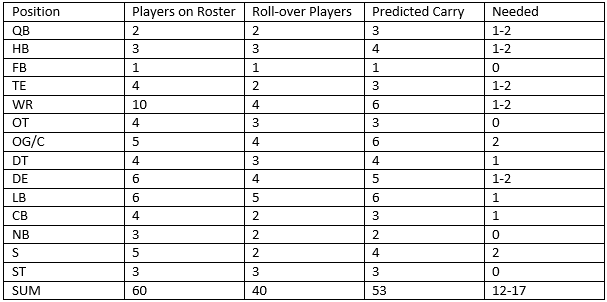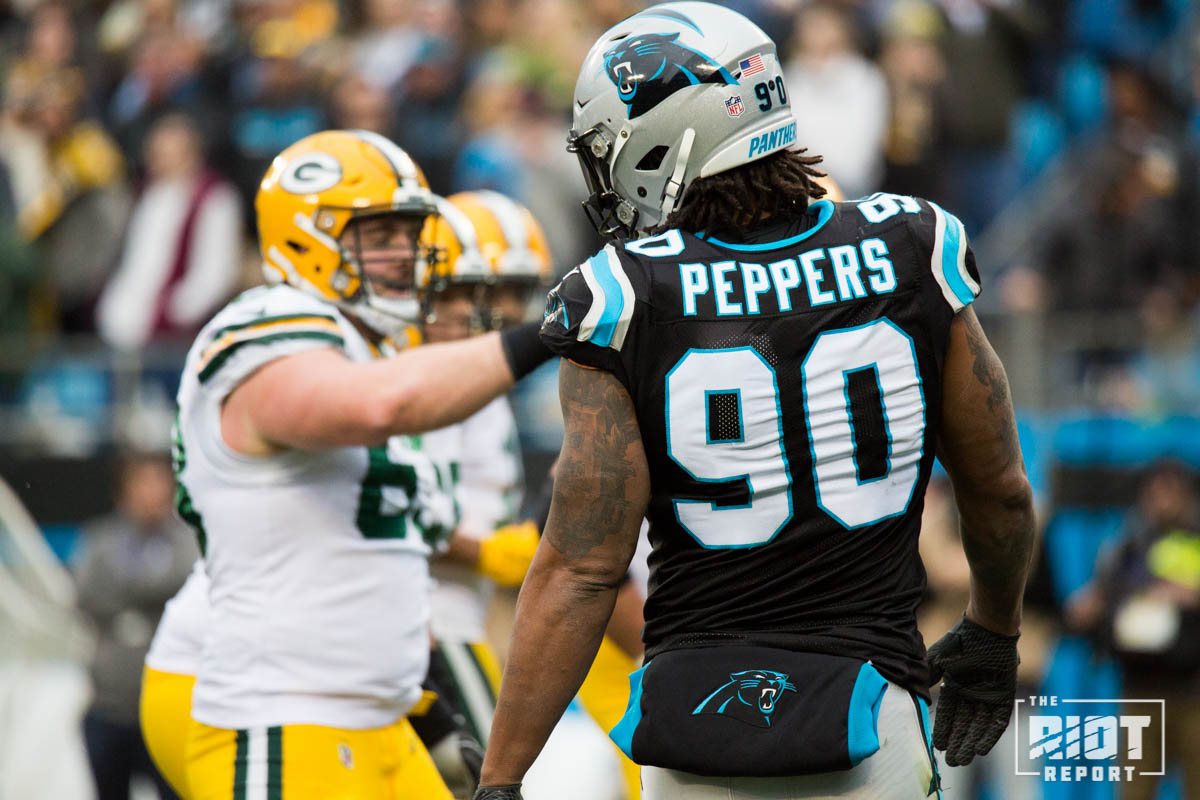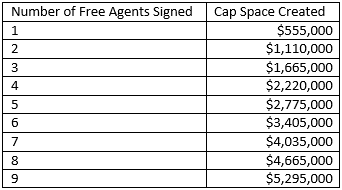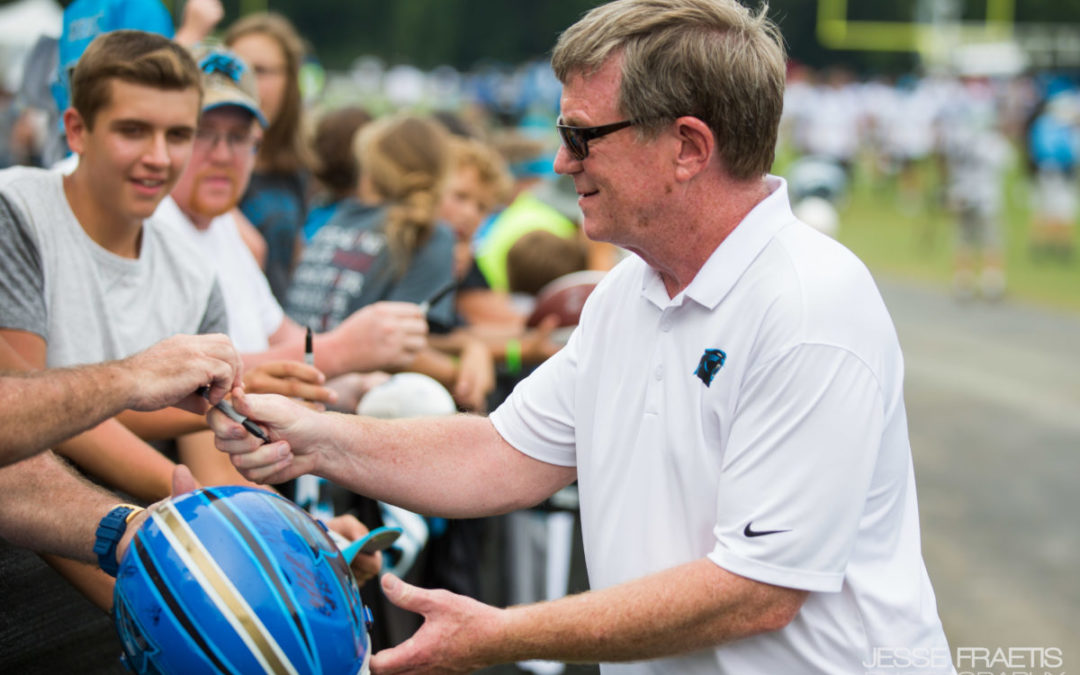With free agency starting yesterday, it is easy to get lost in the unimaginably large numbers that some players have attracted and lose the actual accounting that lies behind all of it; while the Panthers will be making some moves in the upcoming days, there are many reasons why they weren’t and will continue to not be in the market for some of the higher-end players available. While not all cap information is publicly available, with a little help from Spotrac, it’s possible to build up a more detailed understanding of what the Panthers will be dealing with.
How Much Cap Space Do The Panthers Actually Have Left?
First of all, it’s important to know how much absolute cap room the Panthers are dealing with. The 2018 salary cap will be $177.2m, and on top of that the Panthers have a rollover of just over $4.4m, allowing for a total of $181.6m in spending. The Panthers also have just over $7m in dead cap, which reduces that number to $174.6m; the Panthers entered free agency with 61 players under contract for next season for a total of $163.6m, but with only the top 51 players contracts contributing towards the cap, this number was effectively only $158.8m.
However, the Panthers also have to account for the draft, and while it is impossible to tie down exactly how much the Panthers will have to spend on those contracts next season, the sum of the contracts for the players taken at the spots the Panthers have picks last year came to $5.8m. This would also add another eight players to the roster, which leaves the effective cap room at $15.8m.
The Panthers can, of course, look to free up some room by releasing some more players, the most notable option being Russell Shepard or Ryan Kalil, whose releases would free up an additional $2.125m and $7.125m. While neither of these are guaranteed to happen, it is worth noting that these moves might come in handy, although Kalil needs to be cut by Friday to render those cap savings.
Breshaud Breeland’s contract is reportedly for $3.93m in 2018 and so that cap number comes down to $12.5 once the Top-51 adjustment has been made.
Add in Peppers $2.5m guaranteed salary and we’ll take it down to $10.6m for the top 51, but keep in mind these numbers are approximations without exact figures; the salary cap is a fickle animal that we only partially understand.
How Many Free Agents Might The Panthers Add?
While the Panthers still need to sign another 17 players in order to reach the 90 man roster, once the draft picks are taken into account, a number of these training camp spots will be given to UDFAs and low-value free agents who are unlikely to contribute to the 51 man cap. If one examines the Panthers’ roster, a number of needs, or lack thereof become clear.

NOTE: This table doesn’t include the recent signings of Peppers and Breeland.
While there is of course some uncertainty in this, the Panthers are likely to have 10-15 new players on the 53 man roster compared to those currently under contract. While some of those might well be familiar faces such as Ed Dickson or Derek Anderson, there will still be a number of completely new players in the locker room (such as Breeland). Given the Panthers have eight draft picks in 2018; and may trade down to add more; the most accurate estimation would be that the Panthers sign 2-7 free agents in the coming weeks in addition to Peppers and Breeland.
Likely Free Agents Added: 4-9 including Peppers and Breeland

What Positions Are Likely To Be Targeted?
This is largely an extrapolation of the above table as well, with the Panthers all but certain to add a quarterback, tight end, interior offensive lineman, defensive tackle and safety before the draft starts. Given the recent trade for Torrey Smith, the Panthers would likely struggle to justify adding another receiver in free agency without releasing either Smith or Shepard, most likely Shepard; Shepard may actually be a placeholder, should the Panthers find his replacement in the draft, expect Shepard to be released. The same goes for cornerback, having replaced the traded Worley with Breeland, don’t expect the Panthers to bring in another corner, considering Bradberry, Breeland, Seymour, Luke, Elder and Munnerlyn are already there.
While the Panthers are unlikely to spend a huge amount of free agent money on positions which they think they can add effectively in the draft, it would be somewhat surprising for the Panthers not to have added any insurance at the remaining needs in order to avoid having to reach on draft day. In this regard, running back and linebacker could see smaller amounts of spending targeted to them.
Very Likely: QB, TE, G, DT, S
Lower Value FA Likely: RB, WR
How Does The 51 Cap Vary With Free Agent Additions?
As the cap hit is calculated based on the top 51 contracts, as the Panthers add free agents, their cap hit will be somewhat diminished based on the contract of the player that moves out of the top 51. Therefore, the following additional cap will be made available for every free agent signing:

This is clearly not going to radically change the face of the Panthers’ free agent ambitions, but the Panthers could well free up anywhere from $2-5m based on how many free agents they sign.
Cap Created: $2-5m depending on number added
So How Much Money Is That Again?
A middle ground estimation would be that the Panthers look to add seven free agents of any note during the coming weeks, which would free up an additional $4m in cap room to make those signings. This could be added to by the cutting of Shepard or Kalil agreeing to a pay cut, but on it’s own will likely be enough for the Panthers to secure a reasonable improvement pre-draft.
Predicted Remaining Free Agent Budget: $14m
So What Can They Do With This?
Given this spending money, the Panthers will likely have to chose between signing a star at one position and spreading their spending over a number of positions; given the contracts we’ve seen doled out over the first two days of “legal tampering”, I’d guess the Panthers will not be indulging in one of the stars. It should also be noted that most NFL contracts are back-loaded like the Breeland deal, and so the Panthers can likely spend to a total average salary exceeding $20m. The Panthers do have a number of older players going into contract years and so could well afford to spent at a slightly higher level than their 2018 cap figure suggests; for example, the retirements of Kalil and Davis alone will free up $17.6m for next season.
Given that QB, RB, TE, DT, and LB signings are likely more for depth than immediate starters, it is likely the focus of the remaining spending will be on G and S. With Julius Peppers returning next season, any large contracts the Panthers hand out will likely be at either G or S; given the Panthers are expected to be competing for a playoff spot once again next season, it would not be surprising to see another summer of veteran additions for depth at areas like TE or RB.
Despite all this, it is still very hard to tell exactly how the rest of free agency will play out for the Panthers, but the starting point of looking to see how the guard and safety markets play out makes a lot of sense. With former Panthers safety Kurt Coleman signing for $6m/year and the Seahawks bringing back Bradley McDougald for $13.5m over three years, the Panthers may have to spend a chunk of their available cap space on a safety should that market hold. If the Panthers are able to secure a player at both of these positions early on, it will then be easier to judge what price point they will be addressing the remaining positions at. It should be remembered that player such as Coleman, Mike Mitchell, Ted Ginn, Jerricho Cotchery, Mike Remmers and Kyle Love were all fairly minor seeming at the time; not all significant contributions have to come with a big price tag.



